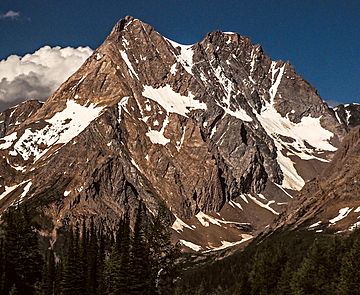Jumbo Mountain (Canada) facts for kids
Quick facts for kids Jumbo Mountain |
|
|---|---|

Karnak-Jumbo Massif, southwest aspect.
Karnak (left), Jumbo (right) |
|
| Highest point | |
| Elevation | 3,437 m (11,276 ft) |
| Prominence | 752 m (2,467 ft) |
| Parent peak | Jumbo Mountain (3437 m) |
| Geography | |
| Location | British Columbia, Canada |
| Parent range | Purcell Mountains Columbia Mountains |
| Topo map | NTS 82K/7 |
| Climbing | |
| First ascent | 1915 |
Jumbo Mountain, sometimes called Mount Jumbo, is a 3,437 meter (11,276 ft) elevation mountain summit located 42 km (26 mi) west-southwest of Invermere in the Purcell Mountains of southeast British Columbia, Canada. The nearest higher peak is Mount Farnham, 11 km (6.8 mi) to the north-northeast, and Karnak Mountain is set 0.79 km (0.49 mi) to the west. Jumbo and Karnak form a double summit massif which is the second-highest mountain in the Purcells, and fourth-highest in the Columbia Mountains. The first ascent of Jumbo Mountain was made August 4, 1915, by H.O. Frind, A.H. & E.L. MacCarthy, M & W.E. Stone, B. Shultz, and Conrad Kain via the North/Northeast Slopes. The peak was named by Edward Warren Harnden after the 1892 Jumbo Mineral Claim on nearby Toby Creek, which in turn was named for Jumbo the elephant. The mountain's name was officially adopted March 31, 1924, when approved by the Geographical Names Board of Canada. Based on the Köppen climate classification, Jumbo Mountain is located in a subarctic climate zone with cold, snowy winters, and mild summers. Temperatures can drop below −20 °C with wind chill factors below −30 °C. Precipitation runoff from the mountain drains into south into Jumbo Creek which is a tributary of Toby Creek, and meltwater from the Jumbo Glacier on its north slope drains into Horsethief Creek which, like Toby Creek, is also a tributary of the Columbia River.
Climbing Routes
Established climbing routes on Jumbo Mountain:
- North/Northeast slopes - First ascent 1915
- West Ridge - First ascent 1974
See also
 In Spanish: Monte Jumbo para niños
In Spanish: Monte Jumbo para niños



